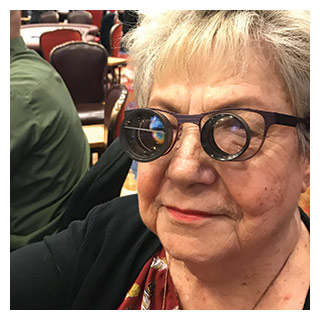By Richard J. Shuldiner, OD, F.A.A.O.
 INTRODUCTION
INTRODUCTIONLow vision care and rehabilitation has been a branch of optometry since William Feinbloom, OD, PhD, first reported on his invention of Bioptic Telescopic Lenses in 1958. Low vision can be considered to be “fully corrected vision which is insufficient to do what you want to do.” Low vision optometrists offer optical, non-optical and electronic treatments to keep those with vision loss as independent and visually functional as possible.
The International Academy of Low Vision Specialists (www.ialvs.org) founded by low vision diplomate Richard J. Shuldiner, OD, FAAO, is a group of 39 highly experienced private practicing low vision optometrists located throughout the U.S. and Canada.
OBJECTIVE
This case study describes how a macular degeneration low vision patient was able to continue playing poker at a local casino with the treatment of low vision aids.
THE POKER PLAYER
While sitting at a Texas Hold-em poker table at the Pechanga Casino in Temecula, Calif., the lady sitting next to me was taking excessive time to make a betting decision. Upon comments from other players, the woman said, “I have macular degeneration, and I have trouble seeing the cards on the table.” After that hand, I introduced myself and gave her my card.
THE CASE
SW, an 81-year-old female suffering from age-related macular degeneration (AMD) presented for a comprehensive low vision examination on July 7, 2017 with the goal of seeing the Texas Hold-em table cards. Her additional goals included reading signs when driving, seeing television clearer and reading newsprint easier.
| Entering Acuity: | DVA: OD 20/50 OS 20/125 |
| NVA: 1.25M OU | |
| Refraction: | Hyperopic Astigmat |
| OD 20/50 OS 20/70 | |
| Visual Field: | Normal |
Prescribed were Designs for Vision 1.7 Full Diameter Telescopic Spectacles with bifocal reading cap for two distances. The top lens focused at a range of 20 to 50 inches and the bottom at 18 inches. This allowed the patient to see the cards in her hand and the cards on the table.
DISCUSSION
20/50 acuity is a difficult level of vision for most macular degeneration patients because they can “almost” see and do most tasks, but just not “clear.” SW was able to see the cards in her hand, and with effort, the cards on the table if she sat at the closest seat to the cards. This patient, as do most AMD patients, required magnification at specific distances to enjoy her hobby. 1.7 x magnification was sufficient magnification, but depth of focus was a concern.
Texas Hold-em seats nine players around an oval table. Each seat has its own distance from the “flop” or cards placed on the table. Under most circumstances, one does not get a choice of seat to play; one takes the place of someone who leaves the table. For this reason, it was necessary to find a magnification device that would allow a depth of focus so she could see the cards from any seat. She also required a hands-free device so she could hold her cards.
The telescopic glasses were dispensed at the casino. The floor manager received permission from the California Gambling Control Commission to use an empty Texas Hold-em table with a certified dealer for the dispensing. Cards were dealt and the patient moved to each seat location to confirm that she could see the cards at each distance. Bioptic telescopic glasses were advised for seeing signs when driving but were rejected. Clear Image II microscope glasses (2x) were prescribed to increase reading speed and enjoyment.













